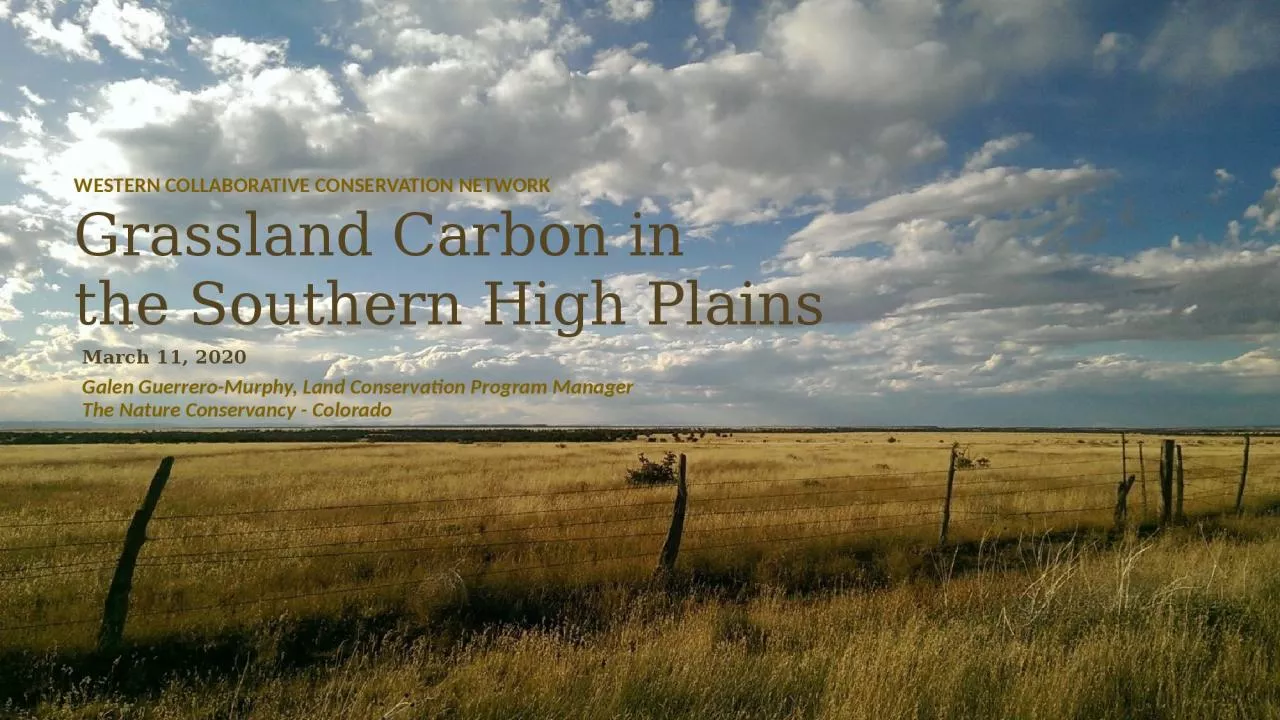

March 11 2020 Galen GuerreroMurphy Land Conservation Program Manager The Nature Conservancy Colorado Grassland Carbon in the Southern High Plains Southern High Plains Initiative Land Use and Cultivation ID: 933378
Download Presentation The PPT/PDF document "WESTERN COLLABORATIVE CONSERVATION NETWO..." is the property of its rightful owner. Permission is granted to download and print the materials on this web site for personal, non-commercial use only, and to display it on your personal computer provided you do not modify the materials and that you retain all copyright notices contained in the materials. By downloading content from our website, you accept the terms of this agreement.
Slide1
WESTERN COLLABORATIVE CONSERVATION NETWORK
March 11, 2020
Galen Guerrero-Murphy, Land Conservation Program Manager
The Nature Conservancy - Colorado
Grassland Carbon in
the Southern High Plains
Slide2Southern High Plains Initiative
Slide3Land Use and Cultivation
Slide4Agricultural Land Use Conversion (2008-2018)
Pixel to pixel change in cropland cover between 2008 Cropland Data Layer (CDL) and 2018 CDL
Dataset derived shows what landcover types were converted to agriculture within the timeframe
Overlay as the quantile distribution of area converted / HUC12
Slide5Climate Mitigation Potential of 21 Natural Climate Solutions in the United States
Source: Fargione et al., Science Advances (2018)
Slide6JE Canyon Ranch Scoping Project
Climate Action Reserve “Grassland Protocol”
Eligibility is based on 4 factors:
Additionality – would conversion have occurred without the project, and would project occur without the voluntary carbon market?
Past land use
–
native grassland for over 30 years
No trees
–
<10% tree cover
Soil quality
–
could soil sustain tilled agriculture
Productivity (stratification) based on:
Soil texture
Major land resource area (MLRA)
Past land use
Slide718.3M unprotected, intact grassland/shrubland acres rated “Non-irrigated Capability Class” 1-4 (SSURGO)
3.9M of these acres are within EPA Integrated Climate and Land-Use Scenarios (ICLUS) Land Use/Landcover Change Projections
EXPLORING SHPI CONVERSION RISK AND GRASSLAND CARBON
Slide8Cultivation Risk
NRCS SSURGO Non-Irrigated Capability Class (1-4) minus current agriculture, developed land, and public/private protected lands. Limited to only
shrubland and grassland landcover
types to show risk of conversion. Mapped as percent of HUC at risk. This dataset is represented as “Cultivation Risk (NICC <= 4)” in the previous map.
Slide9Cultivation Risk /
LULC Projected Change
NRCS SSURGO Non-Irrigated Capability Class (1-4) minus current agriculture, developed land, and public/private protected lands. Limited to only shrubland
and grassland landcover types to show risk of conversion. This data is now constrained by the projected shift to Agriculture based on the EPA ICLUS.This data is represented as “Cultivation Risk in EPA Land Use Projections” in the previous map.
Slide10SUMMARY
In Southern High Plains, 4.7M acres were tilled and cultivated during the period 2008-2018 (releasing ~30% of soil carbon)
Potential expansion of non-irrigated cultivation on approximately 18.3M acres.
Opportunity to leverage Natural Climate Solutions and carbon offsets, particularly Avoided Grassland Conversion projects, for land protection financing
Biodiversity, community and climate co-benefits
Slide11How might we align and communicate “natural climate solutions,” such as grassland carbon storage, with more traditional conservation approaches?
What obstacles exist for the generation and sale of carbon offsets in rural communities and how might we overcome these obstacles? How might grassland carbon markets synergize other conservation models, such as the WRCF buy-protect-sell model, or the WWF impact fund model? How does the timing of payment for offsets effect conservation outcomes (e.g., lump sum payments now, versus smaller but steady long-term cash flows)?
DISCUSSION
Slide12WESTERN COLLABORATIVE CONSERVATION NETWORK
Galen Guerrero-Murphy, Land Conservation Program Manager
galen@tnc.org
(720) 504-5405THANK YOU!